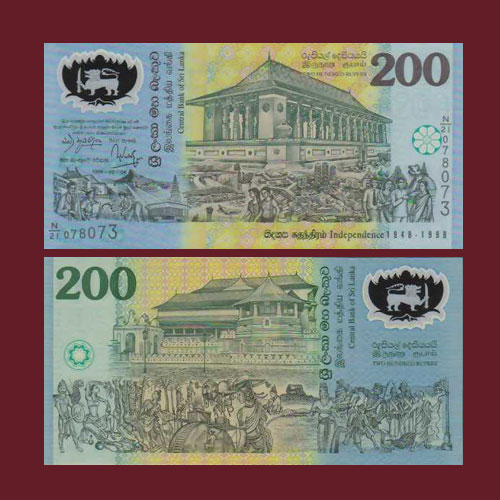History on Banknotes Part II: Sri Lankan Independence!
2017-12-19 Tue
Banknotes can be more than just money. We are back with yet another history lesson! This time we are going to experience the Sri Lankan freedom movement through its banknote which commemorates 50 years of Sri Lanka’s Independence.The obverse of the notes depicts the progress of Sri Lanka in the 50 years of Independence. The design fits many achievements of the Sri Lankan Republic such as
- Free education and health services
- Gal Oya development project
- Electricity development
- Bandaranaike Memorial International
- Conference Hall
- Mahaweli development project
- Bandaranaike International Airport
- Telecommunications development
- Investment Promotion Zone
- New parliament complex of Sri Jayewardenepura, Kotte
- Industrial development
-Development of the Colombo city and the port
-Unity and peace.
While obverse maps the progress of the country into the modern world, the reverse celebrates the National heritage:
- Advent of Prince Vijaya (6th Century B.C.)
- Arrival of Arahant Mahinda and introduction of Buddhism during the reign of King Devanampiyatissa (308 B.C.)
- King Dutugemunu unites Sri Lanka and pays respect to the enemy King Elara and builds the Maha Seya (2nd Century B.C.)
- King Kasyapa builds his palace at the Sigiriya rock fortress and decorates it with frescoes (6th Century A.D.)
- King Parakramabahu the Great constructs the Sea of Parakrama (12th Century A.D.)
- Invasion of Sri Lanka by the Portuguese and the Dutch (16th - 17th Century A.D.) and conquest by the British (19th Century A.D.)
- Wariyapola Sri Sumangala Thero hauling down the British Flag at the Kandyan convention (1815 A.D.).
A result of the peaceful political movement, Sri Lanka or Ceylon achieved its independence from the British on February 4, 1948. Though initially, Ceylon was granted independence as the Dominion of Ceylon, with a Dominion status within the British Commonwealth. It was finally in 24 years later on May 22, 1972, that it became a republic and was renamed the Republic of Sri Lanka!
It’s amazing how such events can still be retold through our modern currencies. Stay tuned for more of such historical and cultural insights! Till then...keep visiting!
To read the earlier article click here.
Latest News
-
Panchala King Bhanumitra Copper Coin
2024-04-26 FriThe Panchala kingdom was ruled by the Mitra kings. The Mitra kings are known to issue coins and most...
-
Mahatma
2024-04-25 ThuIndia Post issued a commemorative postage stamp on #LalaHansraj, also known as Mahatma Hansraj for�...
-
Berar Mint of Muhammad Akbar
2024-04-25 ThuBerar was a kingdom located in the Deccan region, with Elichpur as its capital. It was one of the Su...
-
Janma Kalnayak of Bhagwan Mahavir
2024-04-24 WedOn 21st April 2024 which was the 2550th Janma Kalnyanak of Bhagwan Mahavir Swami, PM Modi unveile...
-
Gold Pagoda of Vijaynagar Empire King Deva Raya I
2024-04-10 WedKing Deva Raya I of the Vijayanagara Empire was a patron of Kannada literature and architecture. He ...

